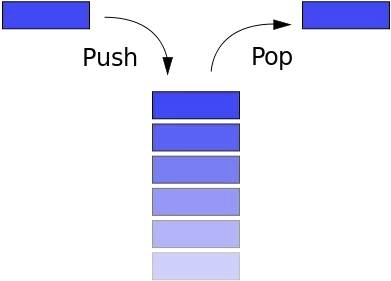 这听起来是否很熟悉:“我在学习课程后开始进行Web开发”?也许您想通过数据结构和算法来提高对计算机科学基础知识的了解。今天,我们将使用JS示例讨论一些最常见的数据结构。
这听起来是否很熟悉:“我在学习课程后开始进行Web开发”?也许您想通过数据结构和算法来提高对计算机科学基础知识的了解。今天,我们将使用JS示例讨论一些最常见的数据结构。1.堆栈(调用)(堆栈)
 堆栈遵循LIFO原则(后进先出-后进先出)。如果您将书本彼此叠放并想拿下最低的书,则先拿上一本,再拿下一本,依此类推。浏览器中的“后退”按钮使您可以(返回)上一页。堆栈具有以下方法:
堆栈遵循LIFO原则(后进先出-后进先出)。如果您将书本彼此叠放并想拿下最低的书,则先拿上一本,再拿下一本,依此类推。浏览器中的“后退”按钮使您可以(返回)上一页。堆栈具有以下方法:- 推送:添加新项目
- 弹出:删除顶部元素,将其返回
- 窥视:返回顶部元素
- length:返回堆栈中元素的数量
JS中的数组具有堆栈属性,但是我们将使用功能Stack()从头开始构建它:function Stack() {
this.count = 0
this.storage = {}
this.push = function(value) {
this.storage[this.count] = value
this.count++
}
this.pop = function() {
if (this.count === 0) return undefined
this.count--
let result = this.storage[this.count]
delete this.storage[this.count]
return result
}
this.peek = function() {
return this.storage[this.count - 1]
}
this.size = function() {
return this.count
}
}
2.队列(Queue)
 队列类似于堆栈。区别在于队列遵循FIFO原则(先进先出-先进先出)。当您排队时,其中的第一个始终将是第一个。队列具有以下方法:
队列类似于堆栈。区别在于队列遵循FIFO原则(先进先出-先进先出)。当您排队时,其中的第一个始终将是第一个。队列具有以下方法:- 排队:进入队列,在末尾添加一个项目
- 出队:离开队列,删除第一个元素并返回
- 前:获取第一个元素
- isEmpty:检查队列是否为空
- size:获取队列中的项目数
JS中的数组具有一些队列属性,因此我们可以将其用于演示:function Queue() {
let collection = []
this.print = function() {
console.log(collection)
}
this.enqueue = function(element) {
collection.push(element)
}
this.dequeue = function() {
return collection.shift()
}
this.front = function() {
return collection[0]
}
this.isEmpty = function() {
return collection.length === 0
}
this.size = function() {
return collection.length
}
}
优先顺序(priority)
队列具有高级版本。为每个项目分配优先级,这些项目将进行相应的排序:function PriorityQueue() {
...
this.enqueue = function(element) {
if (this.isEmpty()) {
collection.push(element)
} else {
let added = false
for (let i = 0; i < collection.length; i++) {
if (element[1] < collection[i][1]) {
collection.splice(i, 0, element)
added = true
break;
}
}
if (!added) {
collection.push(element)
}
}
}
}
测试:let pQ = new PriorityQueue()
pQ.enqueue([gannicus, 3])
pQ.enqueue([spartacus, 1])
pQ.enqueue([crixus, 2])
pQ.enqueue([oenomaus, 4])
pQ.print()
结果:[
[spartacus, 1],
[crixus, 2],
[gannicus, 3],
[oenomaus, 4]
]
3.链表(节点和链接或指针的链表)(链表)
 从字面上看,链表是一个链式数据结构,其中每个节点由两部分组成:节点数据和指向下一个节点的指针。链表和条件数组是带有序列化存储的线性数据结构。区别如下:单链列表具有以下方法:
从字面上看,链表是一个链式数据结构,其中每个节点由两部分组成:节点数据和指向下一个节点的指针。链表和条件数组是带有序列化存储的线性数据结构。区别如下:单链列表具有以下方法:- size:返回节点数
- head:返回第一个元素(head-head)
- 添加:在末尾添加一个元素(尾-尾)
- 删除:删除多个节点
- indexOf:返回节点索引
- elementAt:按索引返回节点
- addAt:在特定位置插入一个节点(按索引)
- removeAt:删除特定节点(按索引)
function Node(element) {
this.element = element
this.next = null
}
function LinkedList() {
let length = 0
let head = null
this.size = function() {
return length
}
this.head = function() {
return head
}
this.add = function(element) {
let node = new Node(element)
if (head === null) {
head = node
} else {
let currentNode = head
while (currentNode.next) {
currentNode = currentNode.next
}
currentNode.next = node
}
length++
}
this.remove = function(element) {
let currentNode = head
let previousNode
if (currentNode.element !== element) {
head = currentNode.next
} else {
while (currentNode.element !== element) {
previousNode = currentNode
currentNode = currentNode.next
}
previousNode.next = currentNode.next
}
length--
}
this.isEmpty = function() {
return length === 0
}
this.indexOf = function(element) {
let currentNode = head
let index = -1
while (currentNode) {
index++
if (currentNode.element === element) {
return index
}
currentNode = currentNode.next
}
return -1
}
this.elementAt = function(index) {
let currentNode = head
let count = 0
while (count < index) {
count++
currentNode = currentNode.next
}
return currentNode.element
}
this.addAt = function(index, element) {
let node = new Node(element)
let currentNode = head
let previousNode
let currentIndex = 0
if (index > length) return false
if (index === 0) {
node.next = currentNode
head = node
} else {
while (currentIndex < index) {
currentIndex++
previousNode = currentNode
currentNode = currentNode.next
}
node.next = currentNode
previousNode.next = node
}
length++
}
this.removeAt = function(index) {
let currentNode = head
let previousNode
let currentIndex = 0
if (index < 0 || index >= length) return null
if (index === 0) {
head = currentIndex.next
} else {
while (currentIndex < index) {
currentIndex++
previousNode = currentNode
currentNode = currentNode.next
}
previousNode.next = currentNode.next
}
length--
return currentNode.element
}
}
4.收集(值)(设置)
 集合(许多)是数学的基本概念之一:一组定义明确且孤立的对象。ES6引入了一个与数组有些相似的集合。但是,该集合不允许包含重复的元素,并且不包含索引。标准集合具有以下方法:
集合(许多)是数学的基本概念之一:一组定义明确且孤立的对象。ES6引入了一个与数组有些相似的集合。但是,该集合不允许包含重复的元素,并且不包含索引。标准集合具有以下方法:- 值:返回集合中的所有项目
- size:返回元素数
- 具有:检查项目是否在集合中
- 添加:添加项目
- 删除:删除一个项目
- 并集:返回两个集合的交集区域
- 差异:返回两个集合之间的差异
- 子集:检查一个集合是否是另一个集合的子集
function MySet() {
let collection = []
this.has = function(element) {
return (collection.indexOf(element) !== -1)
}
this.values = function() {
return collection
}
this.size = function() {
return collection.length
}
this.add = function(element) {
if (!this.has(element)) {
collection.push(element)
return true
}
return false
}
this.remove = function(element) {
if (this.has(element)) {
index = collection.indexOf(element)
collection.splice(index, 1)
return true
}
return false
}
this.union = function(otherSet) {
let unionSet = new MySet()
let firstSet = this.values()
let secondSet = otherSet.values()
firstSet.forEach(i => unionSet.add(i))
secondSet.forEach(i => unionSet.add(i))
}
this.intersection = function(otherSet) {
let intersectionSet = new MySet()
let firstSet = this.values()
firstSet.forEach(function(e) {
if (otherSet.has(e)) {
intersectionSet.add(e)
}
})
return intersectionSet
}
this.difference = function(otherSet) {
let differenceSet = new MySet()
let firstSet = this.values()
firstSet.forEach(function(e) {
if (!otherSet.has(e)) {
differenceSet.add(e)
}
})
return differenceSet
}
this.subset = function(otherSet) {
lat firstSet = this.values()
return firstSet.every(value => otherSet.has(value))
}
}
5.哈希表(Hash Table)
 哈希表是一种基于键值构建的数据结构。由于通过键搜索值的速度很高,因此它用于诸如Map,Dictionary和Object的结构中。如图所示,哈希表具有哈希函数,该哈希函数将键转换为用作键的名称(值)的数字列表。键值搜索时间可以达到O(1)。相同的键必须返回相同的值-这是哈希函数的本质。哈希表具有以下方法:
哈希表是一种基于键值构建的数据结构。由于通过键搜索值的速度很高,因此它用于诸如Map,Dictionary和Object的结构中。如图所示,哈希表具有哈希函数,该哈希函数将键转换为用作键的名称(值)的数字列表。键值搜索时间可以达到O(1)。相同的键必须返回相同的值-这是哈希函数的本质。哈希表具有以下方法:function hash(string, max) {
let hash = 0
for (let i = 0; i < string.length; i++) {
hash += string.charCodeAt(i)
}
return hash % max
}
function HashTable() {
let storage = []
const storageLimit = 4
this.add = function(key, value) {
let index = hash(key, storageLimit)
if (storage[index] === undefined) {
storage[index] = [
[key, value]
]
} else {
let inserted = false
for (let i = 0; i < storage[index].len; i++) {
if (storage[index][i][0] === key) {
storage[index][i][1] = value
inserted = true
}
}
if (inserted === false) {
storage[index].push([key, value])
}
}
}
this.remove = function(key) {
let index = hash(key, storageLimit)
if (storage[index].length === 1 && storage[index][0][0] === key) {
delete storage[index]
} else {
for (let i = 0; i < storage[index]; i++) {
if (storage[index][i][0] === key) {
delete storage[index][i]
}
}
}
}
this.lookup = function(key) {
let index = hash(key, storageLimit)
if (storage[index] === undefined) {
return undefined
} else {
for (let i = 0; i < storage[index].length; i++) {
if (storage[index][i][0] === key) {
return storage[index][i][1]
}
}
}
}
}
6.树
 树结构是多层(多级)结构。它也是一种非线性结构,与数组,堆栈和队列不同。就添加和搜索元素而言,此结构非常有效。这是树结构的一些概念:
树结构是多层(多级)结构。它也是一种非线性结构,与数组,堆栈和队列不同。就添加和搜索元素而言,此结构非常有效。这是树结构的一些概念:- root:根元素,没有父元素
- 父节点:顶层(级别)的直接节点,只能有一个
- 子节点:较低级别的直接节点,可能有几个
- 兄弟姐妹:一个父节点的子节点
- 叶:没有“孩子”的结
- 边缘:节点之间的分支或链接(链接)
- 路径:从起始节点到目标元素的路径(链接集)
- 树的高度:从特定元素到没有子节点的最长路径的链接数
- 节点深度:从根节点到特定元素的链接数。
- 节点度:后代数
这是二叉搜索树(BST)的示例。每个节点只有两个后代,左(子)节点小于当前(父)节点,右(子)节点较大:该 树的方法如下:
树的方法如下:- 添加:添加节点
- findMin:获取最小节点
- findMax:获取最大节点
- 查找:查找特定节点
- isPresent:检查特定节点
- 删除:删除节点
class Node {
constructor(data, left = null, right = null) {
this.data = data
this.left = left
this.right = right
}
}
class BST {
constructor() {
this.root = null
}
add(data) {
const node = this.root
if (node === null) {
this.root = new Node(data)
return
} else {
const searchTree = function(node) {
if (data < node.data) {
if (node.left === null) {
node.left = new Node(data)
return
} else if (node.left !== null) {
return searchTree(node.left)
}
} else if (data > node.data) {
if (node.right === null) {
node.right = new Node(data)
return
} else if (node.right !== null) {
return searchTree(node.right)
}
} else {
return null
}
}
return searchTree(node)
}
}
findMin() {
let current = this.root
while (current.left !== null) {
current = current.left
}
return current.data
}
findMax() {
let current = this.root
while (current.right !== null) {
current = current.right
}
return current.data
}
find(data) {
let current = this.root
while (current.data !== data) {
if (data < current.data) {
current = current.left
} else {
current = current.right
}
if (current === null) {
return null
}
}
return current
}
isPresent(data) {
let current = this.root
while (current) {
if (data === current.data) {
return true
}
data < current.data ? current = current.left : current = current.right
}
return false
}
remove(data) {
const removeNode = function(node, data) {
if (node === null) return null
if (data === node.data) {
if (node.left === null && node.right === null) return null
if (node.left === null) return node.right
if (node.right === null) return node.left
let tempNode = node.right
while (tempNode.left !== null) {
tempNode = tempNode.left
}
node.data = tempNode.data
node.right = removeNode(node.right, tempNode.data)
return node
} else if (data < node.data) {
node.left = removeNode(node.right, data)
return node
} else {
node.right = removeNode(node.right, data)
return node
}
}
this.root = removeNode(this.root, data)
}
}
测试:const bst = new BST()
bst.add(4)
bst.add(2)
bst.add(6)
bst.add(1)
bst.add(3)
bst.add(5)
bst.add(7)
bst.remove(4)
console.log(bst.findMin())
console.log(bst.findMax())
bst.remove(7)
console.log(bst.findMax())
console.log(bst.isPresent(4))
结果:1
7
6
false
7.加载的(前缀)树(Trie,读为“ try”)
 前缀树是搜索树的一种。其中的数据按顺序存储(逐步)-每个树节点代表一个步骤。字典中使用了前缀树,因为它大大加快了搜索速度。每个树节点都是字母的一个字母,跟随一个分支会导致一个单词的形成。它还包含一个“布尔指示器”,用于确定当前节点是最后一个字母。前缀树具有以下方法:
前缀树是搜索树的一种。其中的数据按顺序存储(逐步)-每个树节点代表一个步骤。字典中使用了前缀树,因为它大大加快了搜索速度。每个树节点都是字母的一个字母,跟随一个分支会导致一个单词的形成。它还包含一个“布尔指示器”,用于确定当前节点是最后一个字母。前缀树具有以下方法:- 添加:在字典中添加一个单词
- isWord:检查一个单词
- 打印:返回所有单词
function Node() {
this.keys = new Map()
this.end = false
this.setEnd = function() {
this.end = true
}
this.isEnd = function() {
return this.end
}
}
function Trie() {
this.root = new Node()
this.add = function(input, node = this.root) {
if (input.length === 0) {
node.setEnd()
return
} else if (!node.keys.has(input[0])) {
node.keys.set(input[0], new Node())
return this.add(input.substr(1), node.key.get(input[0]))
} else {
return this.add(input.substr(1), node.keys.get(input[0]))
}
}
this.isWord = function(word) {
let node = this.root
while (word.length > 1) {
if (node.keys.has(word[0])) {
return false
} else {
node = node.keys.get(word[0])
word = word.substr(1)
}
}
return (node.keys.has(word) && node.keys.get(word).isEnd()) ? true : false
}
this.print = function() {
let words = new Array()
let search = function(node = this.root, string) {
if (node.keys.size !== 0) {
for (let letter of node.keys.keys()) {
search(node.keys.get(letter), string.concat(letter))
}
if (node.isEnd()) {
words.push(string)
}
} else {
string.length > 0 ? words.push(string) : undefined
return
}
}
search(this.root, new String())
return words.length > 0 ? words : null
}
}
8.图(graph)(图)
 图(也称为网络)是互连节点的集合。根据链接是否有方向,有两种图形-定向图和非定向图。图形可在任何地方使用,例如,以计算导航应用程序中的最佳路线或在社交网络上创建推荐列表。图形可以列表或矩阵的形式呈现。
图(也称为网络)是互连节点的集合。根据链接是否有方向,有两种图形-定向图和非定向图。图形可在任何地方使用,例如,以计算导航应用程序中的最佳路线或在社交网络上创建推荐列表。图形可以列表或矩阵的形式呈现。清单
在这种情况下,所有父节点都位于左侧,而其子节点位于右侧。
矩阵
在这种情况下,节点按行和列分布,行和列的交点表示节点之间的关系:0表示未连接节点,1表示已连接节点。 通过两种方法搜索图形-广度优先搜索(Breath-First-Search,BFS)和深度深度搜索(Depth-First-Search,DFS)。考虑BFS:
通过两种方法搜索图形-广度优先搜索(Breath-First-Search,BFS)和深度深度搜索(Depth-First-Search,DFS)。考虑BFS:function bfs(graph, root) {
let nodesLen = {}
for (let i = 0; i < graph.length; i++) {
nodesLen[i] = Infinity
}
nodesLen[root] = 0
let queue = [root]
let current
while (queue.length !== 0) {
current = queue.shift()
let curConnected = graph[current]
let neighborIdx = []
let idx = curConnected.indexOf(1)
while (idx !== -1) {
neighborIdx.push(idx)
idx = curConnected.indexOf(1, idx + 1)
}
for (let i = 0; i < neighborIdx.length; i++) {
if (nodesLen[neighborIdx[i]] === Infinity) {
nodesLen[neighborIdx[i]] = nodesLen[current] + 1
queue.push(neighborIdx[i])
}
}
}
return nodesLen
}
测试:let graph = [
[0, 1, 1, 1, 0],
[0, 0, 1, 0, 0],
[1, 1, 0, 0, 0],
[0, 0, 0, 1, 0],
[0, 1, 0, 0, 0]
]
console.log(bfs(graph, 1))
结果:{
0: 2,
1: 0,
2: 1,
3: 3,
4: Infinity
}
这就是我的全部。希望您找到对自己有用的东西。编码愉快!